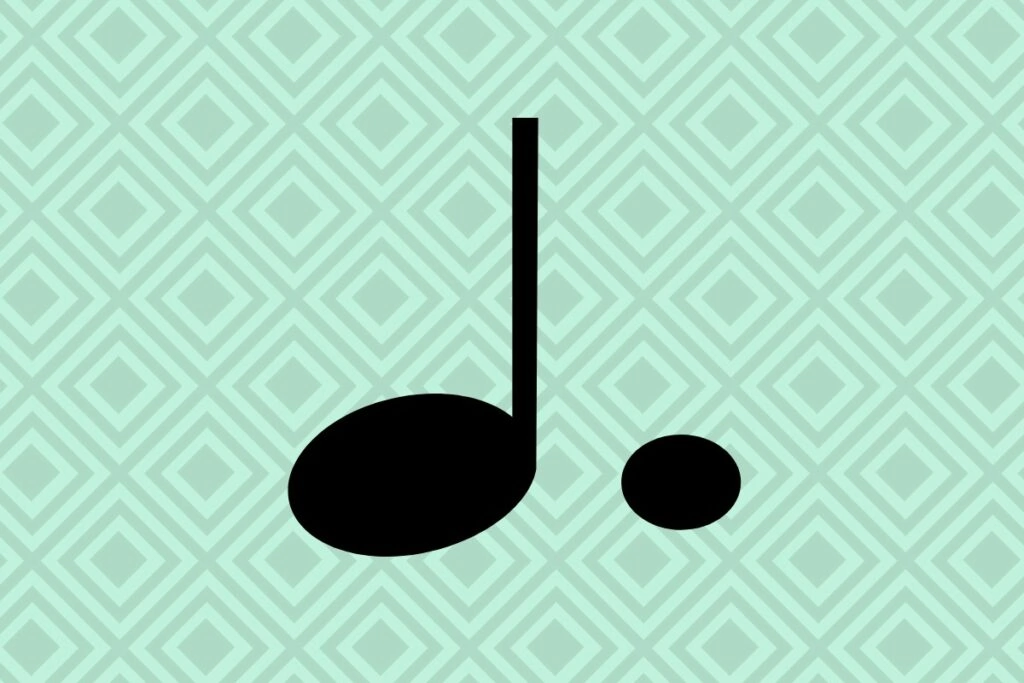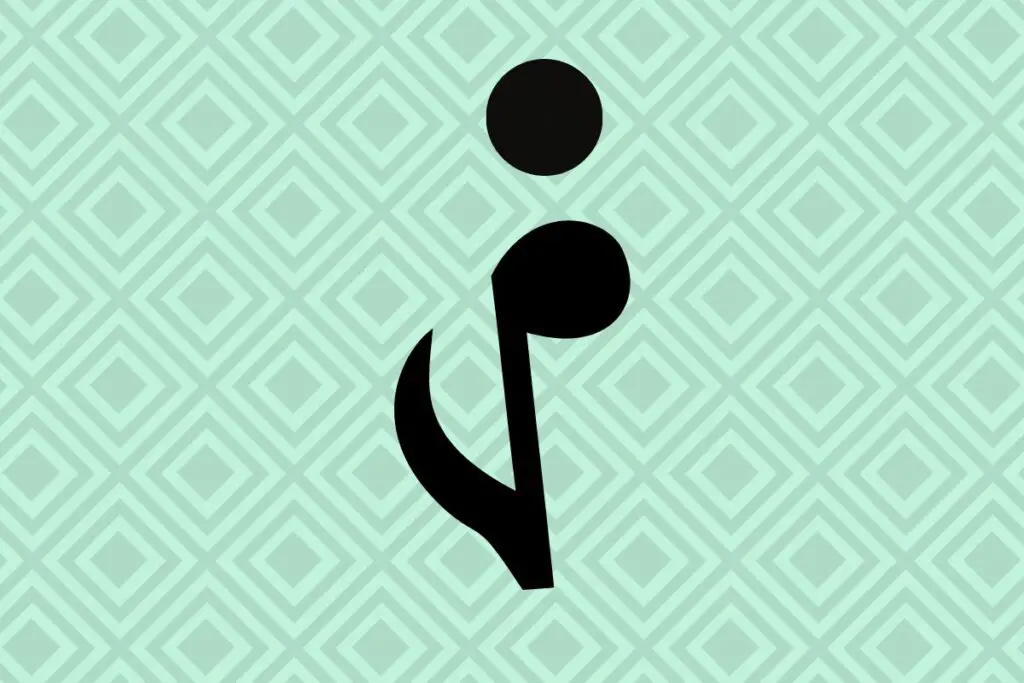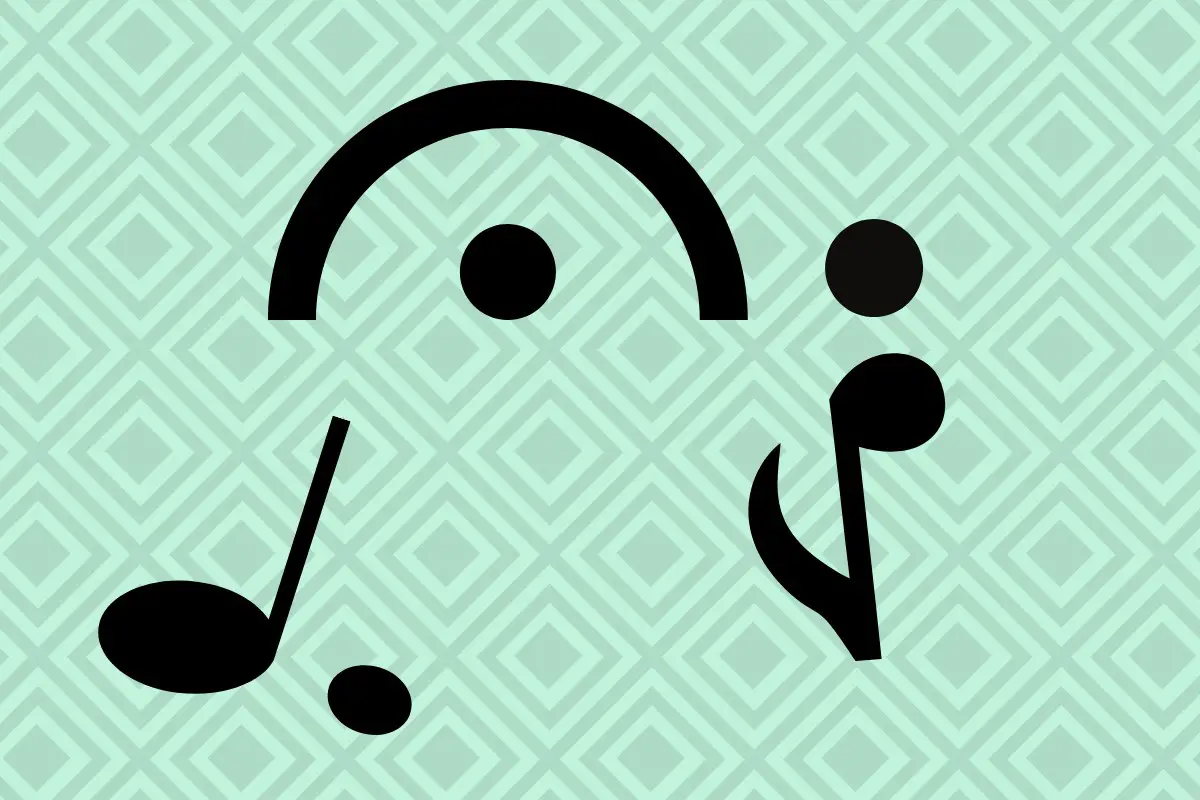When you get into reading music notation, you’ll come across a lot of different things.
One of the ones new musicians worry about is when they see a dot in music.
Dots after a note in music means we extend the value of the rhythm by half. This is called a dotted note. When there’s a dot above a note, it indicates a staccato style for the note, which means it’s played with space around it.
Let’s talk a bit more about these instances (and others) and how they work in music.
Table of Contents
What Does A Dot After A Note Mean?

When you see a dot after a note, you lengthen the rhythmic value of the note by half or 1.5. So a quarter becomes like a quarter note tied to an eighth note. In 4/4 time, this would make it worth 1.5 beats.
The rule for a dot after a note applies to both notes and rests across any time signature and any value.
You always take half of the original note and then add it to the original value.
It’s tough to base the value of the note based on beats as time signatures change which note gets the beat.
But if we assume the time signature is 4/4, the basic ratios will stay the same.
Here are a few examples of the most common dotted notes explained:
(Remember, these all apply to the rests as well.)
Dotted Quarter Note
Dotted quarter notes are one of the most common rhythms you’ll see with dots.
In a typical 4/4 time, the quarter note is worth a beat, so the dots add a half of a beat on top of it.
This brings the dotted quarter note up to 1.5 beats.
Another way to look at it is to think about pure rhythm ratios.
Half of a quarter note is an eighth note.
A dotted quarter note is a quarter note plus an eighth note.
Dotted Half Note
The dotted half note is also quite common, though as a tuba player, I probably see it more than most.
In 4/4 time, the half note is worth 2 beats.
The dot adds half that (1 beat) to the first value, bringing us to a total of 3 beats for a dotted half note.
Looking at the rhythm value, it shakes down like this:
Half of a half note (there’s a phrase, huh?) is a quarter note.
So a dotted half note also equals a half note plus a quarter note.
Dotted Eighth Note
With dotted eighth notes, things start to get a little trickier.
Now, we’re splitting hairs into smaller and smaller pieces.
In 4/4 time, the eighth note gets 1/2 of a single beat.
Half of this (from the dot) is 1/4.
So the dotted eighth note gets 3/4 of a beat (1/2 + 1/4 = 3/4).
I’ll bet you never thought you’d have to do so much math in music, right?
For rhythm values, we look at half the eighth note or sixteenth note.
We add this to the original, so we get a dotted eighth note equaling an eighth note plus a sixteenth note.
Related Reading: Check out what a C with a line through it means in music and how it’s related to 4/4 time.
Dotted Notes Chart
Hopefully, by now, we’ve got a basic idea of how the dots work.
With this in mind, here’s a chart describing most of the common dotted rhythms and how they keep their value in 4/4 time and also as a pair of rhythms.
| Dotted Rhythm | Beat value in 4/4 meter | Rhythm Addition Sentence |
|---|---|---|
| Dotted whole note | 6 | Whole + half |
| Dotted half note | 3 | Half + quarter |
| Dotted quarter note | 1.5 (1 1/2) | Quarter + eighth |
| Dotted eighth note | 0.75 (3/4) | Eighth + sixteenth |
| Dotted sixteenth note | 3/8 | Sixteenth + thirty-second |
| Dotted thirty-second note | 3/16 | Thirty-second + sixty-fourth |
Note: All of this also applies to rests.
What Does A Dot Above A Note Mean?

A dot on top of a note in music means the note should be played staccato. Staccato is spaced and dry, making the note sound short. Take care not to speed up or slow down this rhythm as you play it.
Staccato doesn’t truly change the note itself; it alters the style of the note.
As a style marking (also called articulation), it adds another layer of musicality and artistry to rhythm and melody.
A lot of people use the words “short” or “quick” to describe staccato, but this is a mistake.
“Short” will start to make people play the note in a pinched way.
The tone of the note, whether you’re playing an instrument or singing, will end up being less than ideal.
Something similar happens when you use the word “quick.”
People start to think you need to play faster.
While the spaced notes do add intensity and motion to a piece, they don’t actually add speed.
This is why many other music teachers and I much prefer a word like “spaced.”
What Do Two Dots After A Note Mean?
When you see two dots after a note, you add half and then a quarter of the original value to the rhythm. A lot of people prefer to think of it as adding half and then half of the second half. A double-dotted quarter would be worth 1 and 3/4 beats in 4/4 time.
Looking at a double-dotted whole note may be a much clearer way to see this in action.
The whole note is worth 4 beats on its own.
The first dot adds half that value, which is 2.
With a second dot, the value-added is half of the first dot (which was 2). So we add one more.
4 for the whole note + 2 for the dot +1 for the second dot = 7 beats.
What Is A Dot Under A Circle In Music?
A dot under a half-circle in music refers to a fermata. A fermata is when you hold a note in music. If you’re playing under a director, watch them see how long they want to hold the note. If you’re on your own or in a group without one, the general rule is to hold it twice the length of the original value.
If you want to learn more music theory facts, check out our massive lists of popular songs in different modes.

